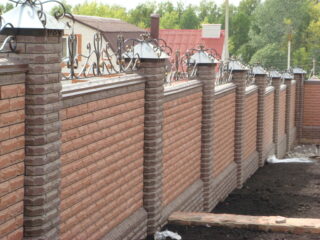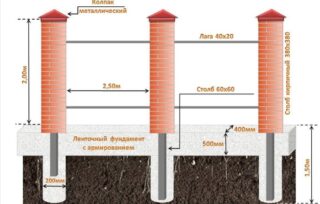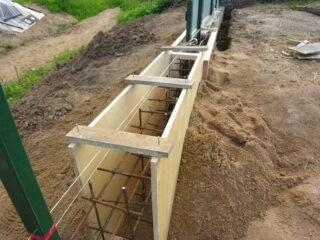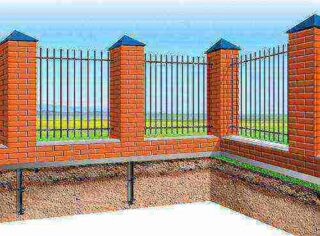Brick fences are one of the common solutions in private construction. They have a beautiful appearance and reliably protect the territory from the penetration of strangers. Laying a brick fence requires a fairly significant amount of land work, but if you have construction skills, you can do it yourself.
Advantages and disadvantages of a brick fence

Fencing a house with such a fence helps protect it from intruders, because it is much more difficult to break the integrity of a brick wall than a wooden one. The design can withstand the effects of precipitation, mechanical stress, the severity of snow masses and other environmental factors. It can serve for several decades. In addition, the fence does not need any special maintenance.
Of the minuses, one can name the need for large-scale land works, which take quite a lot of time, despite the simple technology. Considerable resources can be spent on transportation of the entire volume of materials to the construction site. If the homeowner has the skills to carry out earthworks, pour concrete foundations into formwork and brickwork, he can build such a fence on his own with an assistant. Otherwise, it is better to use the services of a team of craftsmen.
The structure consists of supports, made in the form of brick posts, and walls erected between them. A strip-type concrete base with metal reinforcement is usually used. Before building the foundation, you will need to dig a trench. The work also includes digging holes for the supports. The pillars begin to be mounted only after the base is ready. The final part of the work is the construction of the walls.
Materials and preparation for work

To make a brick fence with your own hands, you need to prepare a sufficient amount of raw materials for the construction of posts and walls. The structure is made from one type of material. You can use bricks of the same size for work, differing in color.
Both simple ceramic bricks and facing bricks can be used. Silicate products differ in strength, but they cannot be used for the foundation and basement part, since there is a high probability that the structure will turn out to be uneven. It is recommended to purchase building materials with a certain margin, as they can split during the laying process.
You need to prepare:
- Round or square tubes 6 cm in length, 0.5-1 m higher than the height of the supports. They are used to reinforce the pillars.
- Reinforcement for knitting the frame of the foundation. Ribbed rods are used for longitudinal laying, smooth ones for transverse. Decking and other sheet materials are not needed for work.
- M200-300 grade concrete.
- Formwork boards (or finished structure).
- Sand for the pillow.
- Cement or industrial mix for masonry.
Before work, debris and obstructing objects must be removed from the site. The surface needs to be leveled. The level is used for control.
You need to decide on the size of the fence - thickness and height. A decorative low (1 m or less) fence in a half-brick looks quite adequate, but the protective fence should be made by laying at least one complete element. It is preferable in this case to make a structure of one and a half to two bricks. The height must be at least 3 m.
It is advisable to prepare a drawing that shows the main components of the structure, their dimensions, the location of the doors and their type (sliding, swing, etc.).
For marking, the site is surrounded by two rows of stakes through which the rope is pulled. The installation points of the pillars are also marked with stakes. The trench can be dug with an excavator. Its minimum depth is 50-60 cm. The specific value is determined taking into account the design of the fence, the grade of materials and the characteristics of the soil. Pits for pillars of one meter depth are created with a drill or a shovel. At the bottom of all depressions and trenches, a coarse-sand pillow 10-15 cm thick is arranged.
Filling the foundation for the fence

Formwork panels are assembled from planks. They should have a smooth front surface. The design is made slightly higher than the intended upper plane of the base. In the future, a step-by-step instruction for the foundation of a brick fence with your own hands looks like this:
- Shields are mounted in a trench and fastened with transverse boards. It is necessary to achieve strictly vertical fixation.
- A reinforcing frame is being prepared. The rods can be tied or joined with a welding machine. The second option is faster to implement, but the frame is less strong.
- The reinforcement is fixed in the trench. Pillars are mounted in the pits.
Then the concrete is poured. For a solid foundation, it is important to do it in one go. The concrete is allowed to harden for the number of days indicated on the package. To prevent it from being washed away by sediments, a plastic wrap is laid on top. Before further work, the foundation is covered with a waterproofing material (for example, a special product based on bitumen).
Brick masonry technology

If the project includes a basement, work begins with its creation. Usually it consists of 4 rows of elements and is laid out in 1.5-2.5 bricks.
To create supports, metal pillars are lined on all sides. Then concrete mixture is poured inside, and the tops are covered with an iron cap. After that, spans are laid out, the height of which is somewhat inferior to that of the pillars.
Before laying the bricks, the base is coated with mortar using a trowel. Excess mixture is removed with the same tool. The evenness of the location of the bricks is checked by the building level. The position of the individual element can be adjusted using a hammer with a rubber tip.
The mortar can be made from cement yourself or you can purchase a finished product. When using facing bricks in the process of work, it is possible to perform color-coded jointing. To do this, when preparing a solution, dyes are introduced into it.








